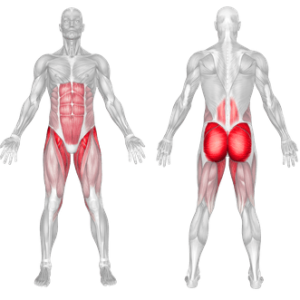Overview
The barbell hip thrust is a strength-training movement designed to isolate and activate the gluteus maximus. Unlike squats or deadlifts, it directly trains the hips in horizontal extension, making it one of the most effective lifts for glute hypertrophy. It is frequently used in powerlifting, bodybuilding, athletic development, and rehab programs.
How to do Perform Barbell Hip Thrust

-
Sit on the floor with your upper back against a bench and a barbell over your hips.
-
Roll the bar to rest across the crease of your hips, placing a pad or towel underneath for comfort.
-
Bend your knees and plant your feet flat, hip-width apart.
-
Brace your core and drive through your heels to lift the hips upward.
-
At the top, squeeze your glutes and pause when your torso is parallel to the floor.
-
Lower slowly back down and repeat for your desired number of reps.
Tips for Proper Form
-
Keep your chin tucked to avoid overarching your lower back.
-
Drive through your heels to engage the glutes rather than the quads.
-
Pause at the top and fully contract your glutes.
-
Use a padded barbell to avoid hip discomfort.
-
Maintain a straight line from shoulders to knees at the top.
Common Mistakes
-
Overextending the back at the top, which reduces glute activation and stresses the spine.
-
Allowing knees to flare out too much or cave inward.
-
Not using full range of motion, limiting the glute contraction.
-
Placing feet too far forward, shifting tension to the hamstrings.
-
Neglecting tempo, especially during the eccentric (lowering) phase.
Benefits of the Barbell Hip Thrust
-
Maximizes Glute Activation: The movement directly targets the gluteus maximus through full hip extension with load. According to research, barbell hip thrusts can activate the glute muscles to a greater degree than exercises like squats and lunges.
-
Improves Athletic Performance: Hip thrusts boost sprinting speed, jumping ability, and overall power output.
-
Reduces Lower Back Strain: Unlike deadlifts or squats, it isolates the hips without overloading the spine.
-
Supports Hip Health and Stability: Strengthening the glutes can improve posture and prevent hip instability and knee injuries.
-
Enhances Glute Hypertrophy: Ideal for bodybuilding and aesthetic goals, this lift helps build rounder, firmer glutes.
-
Versatile for All Fitness Levels: It can be scaled from bodyweight to heavy barbell variations.
-
Balances Lower Body Strength: Complements squat and deadlift training by targeting underused hip extensors.
How to Incorporate Into Your Routine
- For Beginners: Start with 2 to 3 sets of 8 to 10 reps using an unloaded bar or light weight to learn the movement.
- For Hypertrophy: Perform 3 to 4 sets of 10 to 12 reps with moderate to heavy weight, focusing on the squeeze at the top.
- For Strength: Do 4 to 5 sets of 4 to 6 reps using progressively heavier weights and longer rest periods.
- For Functional Training: Pair 3 sets of 6 reps with single-leg hip thrusts or walking lunges for unilateral balance and control.
- For Circuit Training: Include 10 to 15 reps in a full-body or lower-body circuit to keep intensity high and glute activation strong.
- For General Fitness: Use 2 to 3 sets of 10 reps twice a week to maintain glute strength and support posture.
- For Mobility or Recovery: Try banded or bodyweight hip thrusts with higher reps to reinforce glute activation patterns.
Barbell hip Thrust Muscles Worked

Frequently Asked Questions
Is the barbell hip thrust safe for beginners?
Yes, it is safe if performed with proper form and light resistance to start. Begin with bodyweight or a resistance band variation.
Should I feel it in my hamstrings or back?
No, the glutes should do most of the work. If you feel tension in the hamstrings or back, adjust foot position or form.
Can I use dumbbells instead of a barbell?
Yes, dumbbells or resistance bands are great alternatives for home workouts or lighter resistance options.
How often should I do barbell hip thrusts?
Two to three times per week works well for glute development and athletic performance, depending on your training goals.
